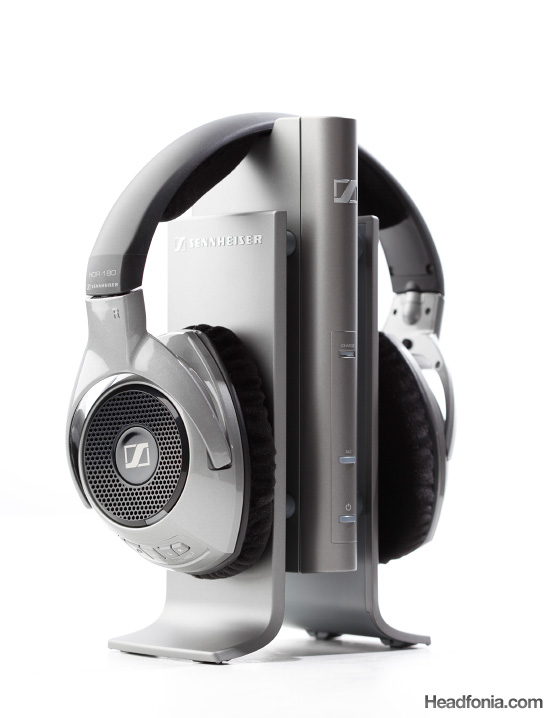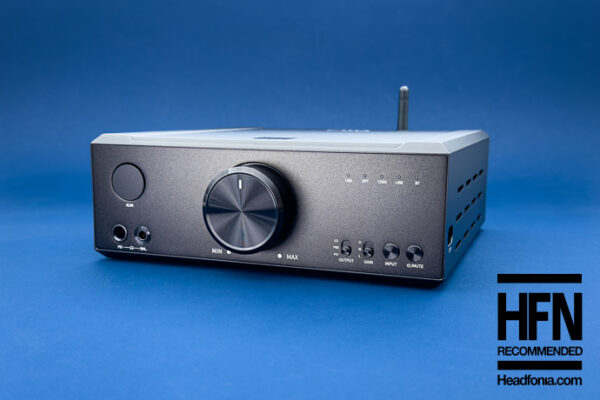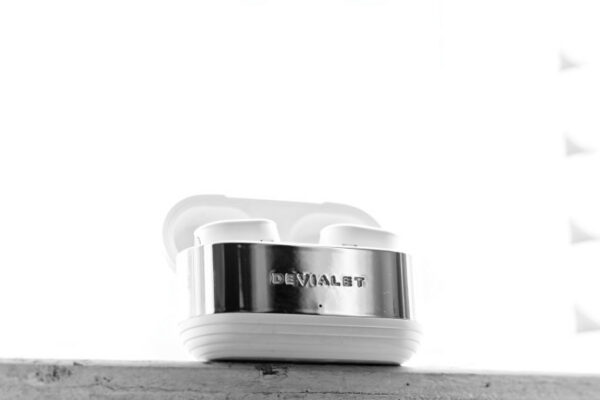The era of real audiophile wireless headphones are finally here. Wireless and audiophiles haven’t been too friendly at each other for a long time, but recently they have found ways to be reconcile their differences. Earlier today I also had the chance to audition the portable Sennheiser PX210BT headphone, which is the new entry portable wireless bluetooth headphone from Sennheiser. Me and several audiophile buddies were present at the auditioning session, and we were totally floored at how a bluetooth portable headphone can give such a rewarding audio experience, even when compared to wired headphones standard (more on the PX210BT headphone on another review).

Wearing a wireless headphone is a new experience for someone who’s been accustomed to wired cables like me. I’m sitting on my office desk writing while listening to the music, and when I need to walk over to the next room to pick something up, I need to take off the headphone. Not so with the RS180 headphone. The freedom you get from wireless is really one of the best invention in headphone technology we have. And listening to the RS180 today, I am quite confident that wireless technology is here to stay.
I first became intrigued by the RS180’s performance when Jude (Head-Fi’s boss) told me that he’s been enjoying music out of the RS180. And indeed, for most of us, it all boils down to the quality of the sound. Since I’m not interested in the gadget factor of the Sennheiser RS180, there must sound good before I want to write something about it. The sound signature is noticeably Sennheiser like, warm, full bodied, smooth, all this while preserving a clear but unobtrusive treble. Although the RS180 doesn’t quite have the level of refinement of the HD650 or the HD800, I definitely think that the RS180 will be easier to enjoy with a wider range of music listeners than the two reference-class headphones. Both the HD650 and the HD800 needs quite a beefy support of equipments before they can really shine, and even then the HD650 would still be too dark for some music, and the HD800 too neutral to be engaging for some other. The RS180 strikes a nice balance between the warm and full bodied Sennheiser sound, yet not quite as dark and as laid back as the HD650.
It has a nice and full midrange throughout the lower to upper mid frequency, and while the bass is not as high in quality compared to the HD650/HD800, the RS180 has fairly full low end body without being boomy. Overall, the tonal balance is very likeable, far more likeable than the reference HD650/HD800 models. Think of it as a lighter footed HD650. The sound doesn’t quite have the weight of the HD650, but at the same time it’s more nimble, less dark, and is more forward and engaging than the HD650. The RS180 is more or less similar to the HD558/598 when it comes to the overall refinement and sound fidelity factor. However, compared to all the Sennheiser I have in my possession: the HD800, HD650, HD598, HD558, and the HD555, the RS180 still stood out as having the most enjoyable tonal balance among the bunch. The difference is mostly in the midrange, where the fuller midrange of the RS180 makes it more engaging and fun, and less dark than the other Sennheiser compatriots (with the exception of the HD800). It is indeed interesting that Sennheiser chose to fit such a fun sounding tonal balance for its wireless model, but at the same time not making it available on the wired models. As it is, the RS180 stands out very strongly due to the tonal balance. A HD650 replacement with an RS180 tonality would be a big hit, I’m sure.







Mike
No Love for the RS180?
Anonymous
Their price on Amazon has just dropped to $234.53 (USD), that is my breaking point. I’m in.
Anonymous
Nice. Thanks for sharing the info.
Mike
$282.40 for these sweet headphones through Amazon.com!
http://www.amazon.com/dp/B002TLT10S/?tag=026bbpl-…
Pat M
These look intriguing, that's for sure. You mentioned using an amp with these. Considering the equipment that I have and the connectors on the headphone stand (I don't get the RCA outs either), would an iPod to RCA out > Imamp > 1/4" hp out to 1/8" mini jack > RS180 be viable and would the Imamp really improve performance of the RS180 a great deal? Or is there some kind of internal amplification already in the RS180 units themselves (batteries in phones, external power source to stand)? Thanks!
Mike
Pat M, the RS180 does all the DAC and amplifier processing inside the headphone, so I don't think adding an external amp in the chain will help anything, except perhaps to add a coloration to the sound.
Robert
Best review I found for these headphones. I was hoping that the rs170s would sound close to the 180s but I have been hearing a lot about how the 180s superiority. Will you be reviewing the rs170s too?
I really want these headphones but I might have to compromise for the closed-back 170s since I'll be living a dorm in the future.
Mike
Hi Robert, no plans for an RS170 review for now. But a friends own one and he enjoys using it. The fidelity factor is not as high as the RS180, but it's still quite an enjoyable headphone. I think you'll enjoy it.
Robert
Awesome. Its interesting how you said the headphones have a built in amp though. Does this mean it won’t make a much of a difference whether or not I’m connecting it to a good dedicated sound card or my onboard audio on my PC?
Mike
Hi Robert,
Theoratically, the wireless signal would be transferred as a digital data. So when the headphone receive it, it needs to do a digital-to-analog conversion (which basically is a DAC), and then it needs to pass the signal to some sort of a mini amplifier inside the headphones.
A good source would still help I suppose, as the better quality source will still make its way through the chain.
Jeff
While it is true that these headphones have a DAC and an amplifier inside the headset, that is separate from the initial D to A conversion needed for the digital file itself.
There is an important distinction here. When one normally speaks of a DAC in this context they are referring to the initial conversion of the digital file into analog music. The quality of that conversion is important regardless of whether you go from there to a pre-amp/wired-headset, or to this wireless device.
So any sonic improvement that you normally get with a nice DAC on high quality uncompressed digital files compared to say, just using the DAC that is built into your laptop, will still be present with these wireless headphones.
Think of all that as your "source" – right up to where you would normally plug in wired headphones. From there, with this wireless solution, the "transmitter" actually takes the analog signal from your source (laptop/cd-player/DAC-preamp) and does a new conversion to a lossless digital stream which it sends wirelessly to the headphones on a 2.4 GHz RF carrier wave. The headset then does another D to A conversion and re-amplification inside the headphone unit.
That second set of A to D and then back to A again is obviously not going to be perfect. This review and others I've read does however suggest that it is pretty darn good and does not meaningfully degrade a high quality musical source.
Mike
Thanks, Jeff. I never meant that the onboard DAC will replace the need for a DAC outside, as the RS180 clearly takes an analog input. Perhaps I didn't make that clear enough though. Thanks for the contribution. 🙂
Anon
Why no digital input on the base unit as this would negate any degradation from the first crappy DAC on a laptop and subsequent ADC on the base station itself? In a world of digital content, HDMI would have been a no brainer but for the licencing fees associated with using said.
Anonymous
Yes, a digital input would’ve made sense. Perhaps it’s less common for the general public?
Robert
Thanks for the clarification guys. BTW Mike, what source(s) did you use to test the RS180?
Mike
I believe I used the HRT Music Streamer II+ and possibly also the Grace m902 DAC. 🙂
Josh
Impressive.
Have you try it on movies?
Just curious how it performs and how good it handle the movies.
Anonymous
Hi Josh,
Unfortunately I did not try it with movies.
Anonymous
Just ordered a pair, and a HRT Music Streamer II… stoked. I’m just discovered your site; fantastic reviews.
I am also planning to use the RCA output on the base station to push onward to my Audioengine A2’s and was wondering if you thought the signal would pick up any troublesome coloration or degradation in the pass-through. Any thoughts on the matter?
Anonymous
Thanks, Rylander.
There would always be degradations when you are passing through a connection point, but at the end I think it would be pretty minute and I wouldn’t worry about it too much.
TonyC
Sennheiser just released the wireless RS220 with digital input.
Mike
Didn’t they announce that last year?
Ken Stuart
Mike, I was looking to buy something like HD558/598, but happened to read your review of the RS180 and realized that wireless headphones equivalent in quality level to 558/598 would have significant advantages for me at times, so I purchased a set.
Since the RS180 is designed to work with a variety of equipment setups, it thereby requires that “audiophiles” experiment with different connections and relative levels between source and headphones, as well as attenuator on/off, in order to get the best possible sound they are capable of.
Personally, I find the RS180 to have the most accurate reproduction of electric guitar based music of any headphone I have heard (which is many less than you, of course). Since you state:
” It is indeed interesting that Sennheiser chose to fit such a fun sounding tonal balance for its wireless model, but at the same time not making it available on the wired models. As it is, the RS180 stands out very strongly due to the tonal balance. ”
then I think that you should include the RS180 in the Full-Size-Headphones Recommendations, perhaps just change the HD558/HD598 paragraph to HD558/HD598/RS180 and add a sentence to the end that the RS180 adds wireless at a similar quality level, and with a better tonal balance, and then include a link to your review.
Otherwise, readers rarely end up in the Wireless section, because everyone has the preconception that Wireless means a sound compromise, and your review shows that it no longer does.
awesome1981
I didnt like the ear pads of RS180 but would have preferred the rs 170 ear pads instead. what do you think
Ken Stuart
What don’t you like about the RS180 ear pads ?
(Headphone fit and feel varies from person to person, just like shoes.)
awesome1981
Well the texture of the fabric. I wish it was a smooth as the rs 170 ear pads
L.
Didn’t get a chance to listen to the 170, sorry
Jon Dekievit
The RS160 and 170 use leatherette whereas the 180 uses valuer. They are all interchangeable.
Israel Best
Hi, I own the RS180’s and I am absolutely loving them! Great sound and they are perfect for sitting on the couch and listening to music or watching a movie without waking the kids up.
I was wondering if it would be beneficial for me to add a dedicated DAC/headphone amp into my setup? I am currently using a Sony STR-DB795 receiver for amplification and my RS180’s are hooked up to the headphone output. Or do the inbuilt DAC’s in the headphones negate the need for this?
Mike
Well if you hook it to an external amp and DAC there’s definitely going to be a double DAC/Amping there, but still you’ve got to hook the RS180’s to some sort of a source somewhat, and a better quality source is definitely going to sound better than a lower quality one.
gfmucci
Does anyone have a comparison between these and the HDR170’s?
dalethorn
The only discussions I remember are on the HiFiHeadphonesUK forum. You should be able to do a search there and find a few tips.